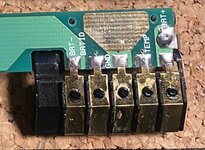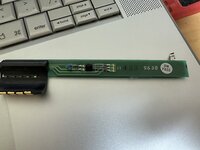-
Updated 2023-07-12: Hello, Guest! Welcome back, and be sure to check out this follow-up post about our outage a week or so ago.
You are using an out of date browser. It may not display this or other websites correctly.
You should upgrade or use an alternative browser.
You should upgrade or use an alternative browser.
PowerBook 5300-gotchas?
- Thread starter Snial
- Start date
LaPorta
Well-known member
All the battery parts (except the old cells).What does? I'm lost
3lectr1cPPC
Well-known member
Oh really? Didn't know that. What does the IDPROM handle?If it's anything like PBDuos, the 3-pin package is not a BMS, just a Dallas IDPROM. The only battery management is a thermistor.
3lectr1cPPC
Well-known member
croissantking
Well-known member
Brilliant, I guess I could do the same thing! I'm a bit confused as to why we only need to solder them together if we've got tabbed 'A' cells, but need to spot weld if they don't have nubs? For example, is it because of the surface area on the ends of the battery preventing soldering from working (or I need a MW soldering iron?)
You can solder the bare ends of the cells but need to roughen up a bit with sandpaper first.
Yes, it’s this. The cells I installed in the 1400’s battery were originally destined for a PB180 rebuild, but clearance is so tight that I just couldn’t manage it with solder.Or the fact that solder isn't flush whereas a spot weld is?
Do you mean where I’ve soldered two cells together? I can take a pic tomorrow.As it is, I think I might take the same approach as for @croissantking, since it looks like you're getting about 80% of the battery for 10% of the effort/ specialised resources and batteries of that era were pretty low range anyway. What do the connections look like from the side?
I got 10x A size cells for £21 delivered. A quick look on RS shows that they’re selling a single battery of this sort for over a tenner, e.g. here: https://uk.rs-online.com/web/p/speciality-size-rechargeable-batteries/0231033 . So… I’m not understanding.And why choose Ebay, rather than RS components for new batteries, much cheaper?
3lectr1cPPC
Well-known member
Ah, just a good ol' dumb battery. I have to say with how much BMS trouble I've had with my 500 series batteries, I quite prefer that.Correct, blue is a thermistor. What does the IDPROM handle, you ask? Just battery ID checking. "This is an Apple battery, S/Nxxyyyyy". If that much. I've forgotten the details, can peruse my notes at some other point.
I know you can get away with doing this, and that's fine and all, but I feel like it's a lot of unnecessary risk... You can get a workable spot welder for under $100. Especially if you're ever working with Lithium cells. "DON'T SOLDER DIRECTLY TO THE BATTERY" is written in the safety section of manufacturer datasheets for a reason.You can solder the bare ends of the cells but need to roughen up a bit with sandpaper first.
I don't feel like it's the sort of thing that NO ONE should do per say, but I'd just worry that recommending it could lead to someone who doesn't know what they're doing lighting a fire.
jmacz
Well-known member
I have a fixed/restored 5300c with internal zip drive and working rebuilt battery (and working pram). Even has the power jack replaced with a standard 5.5mm jack so I can use any modern 24V charger. But it just sits there. Haven’t touched it since fixing it. Maybe I will play with it one of these days but I am more drawn to my 540c.
croissantking
Well-known member
Interestingly, the PB1400 battery has 5 contacts, but BattID and Temp don’t seem to be connected to anything. Seems it is designed for an intelligent battery but didn’t ship with one. EDIT: I might be wrong about this, at least for the temp connection as there is a temp sensor on the other side of the board.Ah, just a good ol' dumb battery. I have to say with how much BMS trouble I've had with my 500 series batteries, I quite prefer that.

Thanks for pointing that out. I’ll add in a disclaimer in future if I bring up the idea of soldering batteries.I don't feel like it's the sort of thing that NO ONE should do per say, but I'd just worry that recommending it could lead to someone who doesn't know what they're doing lighting a fire.
Last edited:
Phipli
Well-known member
My advice is to plan it. Use a high power iron so you can do it quickly without putting too much heat (heat<>temperature) into the batteries and work with an explosion containment pie dish close at hand so you can use tongs to drop a burning battery into the dish if it ignites. Never work with flammable materials near the batteries and never ever ever work on an MDF table - MDF burns really well and releases toxic fumes.Thanks for pointing that out. I’ll add in a disclaimer in future if I bring up the idea of soldering batteries.
Do not try to put the fire out with water, it doesn't work. A bucket of sand is good containment.
LaPorta
Well-known member
My advice is to plan it. Use a high power iron so you can do it quickly without putting too much heat (heat<>temperature) into the batteries and work with an explosion containment pie dish close at hand so you can use tongs to drop a burning battery into the dish if it ignites. Never work with flammable materials near the batteries and never ever ever work on an MDF table - MDF burns really well and releases toxic fumes.
Do not try to put the fire out with water, it doesn't work. A bucket of sand is good containment.
Great advice…thanks for that.
croissantking
Well-known member
Oh, you were *just* talking about that:Interestingly, the PB1400 battery has 5 contacts, but BattID and Temp don’t seem to be connected to anything.
Here’s a photo of that board. The blue one is the thermistor I believe.
Where is the IDPROM?Correct, blue is a thermistor. What does the IDPROM handle, you ask? Just battery ID checking.
3lectr1cPPC
Well-known member
The black thing that looks like a transistor.
Phipli
Well-known member
You can't tell a transistor from its appearance - they come in standard packages that many different components can be found in.The black thing that looks like a transistor.
That one is called "TO-92" and I've seen transistors, diodes, temperature sensors, serial number chips, even infra red sensors and all sorts, that come as a TO-92.
3lectr1cPPC
Well-known member
Good to know.
3lectr1cPPC
Well-known member
Another thing I just thought of - how come no one complains about performance on a PPC-upgraded PowerBook 500 Series? I mean, yes, there are some EXTREMELY rare high clocked ones, but the majority you'll find are ones that are running at similar speeds to the 5300, still with no L2. How come when you're talking about a 5300, someone always brings up how they're slow and therefor not desirable, yet people are typically way more positive when talking about the upgrades for the 500 series. Is it just because people are more likely to see something more rare as desirable? Not sure.
I can't even imagine that the fastest and rarest of the 500 series upgrades would compare well against a 1400 with L2, except for the 183MHz version which does apparently have it.
Thoughts?
I can't even imagine that the fastest and rarest of the 500 series upgrades would compare well against a 1400 with L2, except for the 183MHz version which does apparently have it.
Thoughts?
Phipli
Well-known member
Did they sell that many upgrades? How much did they cost new?Another thing I just thought of - how come no one complains about performance on a PPC-upgraded PowerBook 500 Series? I mean, yes, there are some EXTREMELY rare high clocked ones, but the majority you'll find are ones that are running at similar speeds to the 5300, still with no L2. How come when you're talking about a 5300, someone always brings up how they're slow and therefor not desirable, yet people are typically way more positive when talking about the upgrades for the 500 series. Is it just because people are more likely to see something more rare as desirable? Not sure.
I can't even imagine that the fastest and rarest of the 500 series upgrades would compare well against a 1400 with L2.
Thoughts?
Part of the reason is the 5300 felt like a lie, it was slower than its MHz suggested and cost a lot, so when you forked over a lot of cash, if you hadn't read an honest review in time, it was a big disappointment.
At least a 25MHz 040 based PowerBook performed like a 25MHz desktop.
3lectr1cPPC
Well-known member
Wikipedia claims Apple sold around 6000, and newertech sold over 15000. Currently trying to find some prices on the wayback machine.
I get the issues at the time when new that made them so hated (just read the 5300 REA service source doc!) - I'm talking more about opinions now, and specifically on speed. I feel like people associate the 5300 with being slow while associating the 500-PPC with being fast, even though neither would presumably feel very quick, especially if you try running newer Mac OS versions on said 500-PPC.
I do feel like people undersell the 5300's performance because of how underwhelming it was on launch though. Doom is a laggy mess on my 540c, but the 5300 plays it smooth. Neither feel fast in the OS, but the improvements are there and obvious once you start running programs.
I get the issues at the time when new that made them so hated (just read the 5300 REA service source doc!) - I'm talking more about opinions now, and specifically on speed. I feel like people associate the 5300 with being slow while associating the 500-PPC with being fast, even though neither would presumably feel very quick, especially if you try running newer Mac OS versions on said 500-PPC.
I do feel like people undersell the 5300's performance because of how underwhelming it was on launch though. Doom is a laggy mess on my 540c, but the 5300 plays it smooth. Neither feel fast in the OS, but the improvements are there and obvious once you start running programs.
Similar threads
- Replies
- 32
- Views
- 1K

